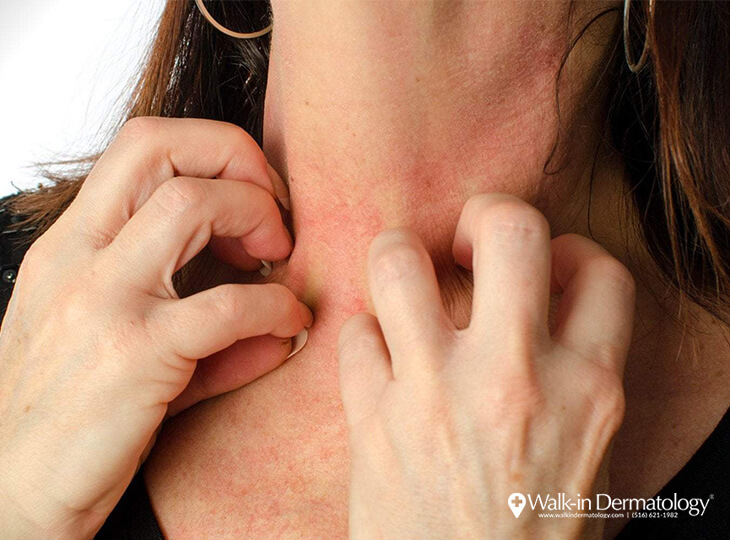Tues: 8:30am - 3:00pm
Wed: 12:00pm - 6:00pm
Thurs: 8:30am - 3:00pm
Fri: Closed
Sat: 8:30am - 12:30pm
Sun: Closed
Greenvale, NY 11548
What you Should Know about Silver and Nickel Allergies


A silver allergy is a form of metal hypersensitivity, which is a disorder of the immune system. It’s a condition that affects around 10 to 15% of the population, although it mostly affects women. A silver allergy can produce a reaction called contact dermatitis, which includes symptoms such as swelling, rashes, or pain.
Most of the time, these skin allergies are actually nickel allergies. Because pure silver is usually too soft to be made into jewelry, a small amount of nickel is mixed in to keep the silver firm and lustrous. When the nickel seeps out of the jewelry, it comes into contact with the skin and can cause an allergic reaction. By avoiding nickel substances and using alternative metals such as sterling silver, you should be able to wear silver jewelry with no skin problems.
What is a Nickel Allergy?
A nickel allergy occurs when the body’s immune system views the nickel ions as foreign threats. Most of the time, the cells that make up your immune system will only fight off viruses, bacteria, and other toxic substances. In cases of metal hypersensitivity, the immune system rejects the metal substance and produces a variety of symptoms to combat it.
Metals such as nickel, cobalt, copper, and chromium are usually the culprits of these allergic reactions. These metals are found in everyday items such as jewelry, watches, and coins. These metals are frequently mixed into silver to make the product stronger and more resistant to rust. For some silver jewelry, nickel is also used as the base metal.
Patients who have autoimmune disorders are at a higher risk for metal hypersensitivity, because their immune system is in a constant state of activity. You are also more likely to develop a nickel allergy if your family members are allergic as well.
Signs of an Allergic Reaction
A nickel allergy often occurs after prolonged exposure and only in the area of the skin the nickel came into contact with. Symptoms of contact dermatitis will begin to appear within 24 to 48 hours and can last for 2 to 4 weeks. Common signs of an allergic reaction include:
- Rashes
- Hives
- Swelling
- Itching or irritation
- Redness
- Tenderness
- Bumps
- Dry patches that resemble a burn
- Blisters and draining fluid
- Bluish-green discoloration
How to Test for a Nickel Allergy
To learn whether you have nickel allergy, you should visit your dermatologist. They may order a laboratory test where a sample of your blood will be taken. Laboratory technicians will observe your white blood cells’ reaction to nickel ions and check if any physical changes occur with the cells. Increased activity of white blood cells indicates a nickel allergy.
Your dermatologist may also conduct an allergy test by exposing various metal ions to your skin, to see if there is a negative reaction. This is called a “patch test” where the suspected ions are applied to the patch. The patch is placed on the skin for 48 hours and removed by the doctor. If the skin shows signs of contact dermatitis, then the diagnosis may be a metal allergy.
Tips for Avoiding Allergic Reactions
The simplest way to avoid a nickel allergy is to remove the item that causes the reaction. This may be difficult if the jewelry’s base metal is unknown. If you suspect that a piece of jewelry is causing your skin discomfort or discoloration, take it off until it heals then put it on again to see if it causes a similar reaction. Here are three other ways you can avoid a nickel or silver allergy.
- Find substitute materials: Instead of silver jewelry pieces, you can invest in more expensive metals such as sterling silver or titanium to avoid these allergic reactions. Other ordinary items such as watchbands, buckles, and clothing fasteners can be replaced by plastic or fabric counterparts as well.
- Add barriers to the items: With silver jewelry, you can add several coats of clear nail polish to create a barrier between the metal and your skin. Add three coats of nail polish to limit your skin’s exposure to irritants, and reapply additional coats after a few wears.
- Purchase hypoallergenic jewelry: If you’re allergic to nickel, always check first with the sales clerk about the metals used in the piece you are planning to buy. You can also use alternative, nickel-free jewelry such as titanium, platinum, sterling silver and 18K gold. Be sure to avoid plated or mixed-metal jewelry such as white gold.
Different Hypoallergenic Metals you Can Wear
There is a wide range of nickel-free metals you can choose for your hypoallergenic jewelry, piercings, and accessories: sterling silver, or surgical-grade steel and gold. Here are some alternatives to replace silver jewelry:
- Sterling silver: Sterling silver is an alloy that contains 92.5% silver and 7.5% copper. Most people who want to wear nickel-free jewelry can safely wear sterling silver, but be careful because you may be allergic to silver or copper as well.
- Stainless steel: Stainless steel is an alloy that combines steel, chromium, iron, and nickel. These have different variants, depending on the amount of metal content in the jewelry. Surgical grade stainless steel is used in surgical instruments, and is best for piercings.
- Titanium: If you have a nickel allergy and want to take care of your skin, titanium is a popular choice. It’s a lightweight and sturdy material that is great for silver-gray jewelry. It’s also ideal if you are unsure about your allergy to nickel or other metals, since it comes in different grades.
- Niobium: Niobium is similar to titanium, and is frequently used for creating medical implants. It’s great for people who are allergic to nickel because it’s never painted or plated, and it doesn’t contain additives.
- Gold: Gold can be purchased in different karat counts, the purest being 24K. However, 24K gold is too soft for jewelry so it’s mixed with other metals and alloys. For example, 14K gold or white gold is made with gold and silver or other white metals such as palladium. People with nickel allergies should ask about the jewelry they plan to buy.
Get Tested for Allergies at Walk-in Dermatology
At Walk-in Dermatology, our team of highly experienced medical professionals and board-certified dermatologists will diagnose and treat your skin allergies. Our doctors specialize in both medical and cosmetic dermatology, so we can help your skin to look and feel its best. Book an appointment with us.








